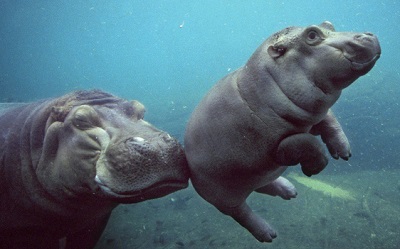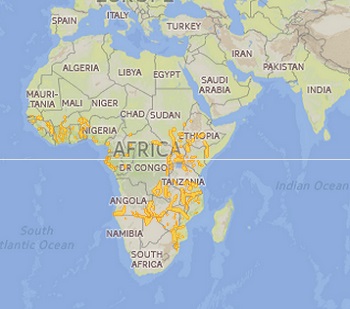Taxonomy

Mother and baby hippopotamus from the Toronto Zoo. The river or common hippopotamus is considered a vulnerable species by the IUCN.
- Kingdom: Animalia
- Phylum: Chordata
- Class: Mammalia
- Order: Artiodactyla
- Family: Hippopotamidae
- Genus: Hippopotamus
- Species: Hippopotamus amphibious
0
0
Name
- Common name: Common hippopotamus, river hippopotamus, Nile Hippopotamus, large hippo.
- Scientific name: Hippopotamus amphibious. Hippos from the Greek word “horse”, potamos from the Greek “river or rushing water”.
Physical Features
- The common or river hippopotamus is the third largest living mammal on earth after the elephant and rhinoceros.
- It has a barrel shaped body and short legs.
- Its tail is laterally flattened and measures up to 14 in or 35 cm.
- Its head is adapted for submersion. Ears, nostrils and eyes are located high on the skull. They close their nostrils when submerged in water.
- Hippopotamus have partial webbing on their feet.
- Hippos have large canine and incisor teeth which are continuously growing but wear out because they grind together. They are used when fighting. Canines in males can grow up to 1.5 ft or 50 cm and are twice as long as females’. The incisors are used for digging.
- Its skin is purple gray to brown and covered in short fine scant hair. It is 6 in or 15 cm thick.
- They have short bristles in the tail, back and head.
- Their mucous glands secret a red thick fluid that protects the skin against sun rays and insect bites.
- Hippopotamuses are considered pseudorumiants.
Length and Weight
- Sexual diphormism is present in this species; males are larger and heavier than females.
- Common hippos range from 4.9 to 5.4 ft or 1.5 to 1.65 m in height and from 9.8 to 16.6 ft or 3 to 5 m in length.
- Male hippos weigh up to 3,253 lb or 1,475 kg and females up to 2,344 lb or 1,360 kg.
Distribution and Habitat
- The common hippopotamus is distributed through 37 countries in South Saharan Africa.
- They are extinct in Algeria, Egypt, Mauritania and Liberia.
- Hippos are semi aquatic animals, they spend their days in water and nights on land. Their habitat includes shallow waters in rivers, estuaries, lakes, swamps and muddy wallows in savannas and forest areas. At night they leave the water to graze on land.
Behavior
- They spend days submerged in water with their eyes, ears and nostrils above surface.
- Hippos are nocturnal animals. They leave the water before dark to find food and graze for 5 to 6 hours. They even nap on land at night. They stay within 6 to 2 miles or 1 to 3 km from their water territory.
- Even though they are semi aquatic they cannot swim or float.
- In times of drought hippos migrate to other sources of water.
- Hippos are social animals living in groups of an average of 30 individuals.
- Males defend their territory in water not on land.
- They communicate by visual signs, vocalization and scent.
- Vocalizations include bellows, grunts and shrieks.
- Their bodies are able to thermoregulate. Water and mud are used to cool their bodies in hot temperatures and sun is used for warming up.
- Adult hippos can stay under water for 5 minutes.
- Males spray dung on the face of other males.
- Hippopotamus have low metabolism and can fast for several weeks.
Diet
- Hippos are herbivores. Most of their diet consists of grass on land and they can consume up to 150 lb or 68 kg of grass each night.
- They do not consume aquatic plants even though they spend their days submerged in water.
Reproduction
- Female hippos reach reproductive maturity at 5 to 6 years of age while males at 7 to 8.
- Females give birth every two years if nutritional conditions are met.
- Gestation period is 8 months.
- Mating and birth occur under water.
- Prior to giving birth the female isolates herself and becomes aggressive.
Life Expectancy
- Life expectancy for the common hippopotamus is 35 to 50 years. The longest recorded is 61 in captivity.
Predators
- Adult hippopotamuses have no known predators other than humans. Young hippos can become prey to lions, crocodiles and hyenas.
Threats
- This species major threat is humans. They are killed for its meat and as trophy for its tusks as well as for destroying crops.
- There has been a population decline of up to 20% in the past decade. The IUCN predicts a 30% decline in the next 30 years.The largest decline has been seen in the Democratic Republic of Congo.
- Specialized ecology and loss of grazing areas due to development and human settlements.
Conservation Status
- The common or river hippopotamus is considered a vulnerable species by the IUCN Red List of Threatened Species.
- Its trade is regulated by Appendix II of CITES.
Did you know?
- Two species of dwarf hippopotamus from Madagascar are extinct (Hippopotamus madagascariensis and Hippopotamus lemerlei)
Fun Facts
- The closest living relatives of hippos are whales.
- The heaviest hippo weighed 9,900 lb or 4,500 kg.
- A group of hippos is called herd, pod, school or bloat.
- The plural of hippopotamus can be either hippopotamuses or hippopotami.
References and further research
San Diego Zoo Library – Hippopotamus amphibious
University of Michigan Museum of Zoology – Hippopotamus amphibious, hippopotamus
IUCN Red List of Threatened Species – Hippopotamus amphibious
The Animal Aging and Longevity Database – An Entry for Hippopotamus amphibious
ITIS Report Hippopotamus amphibious




